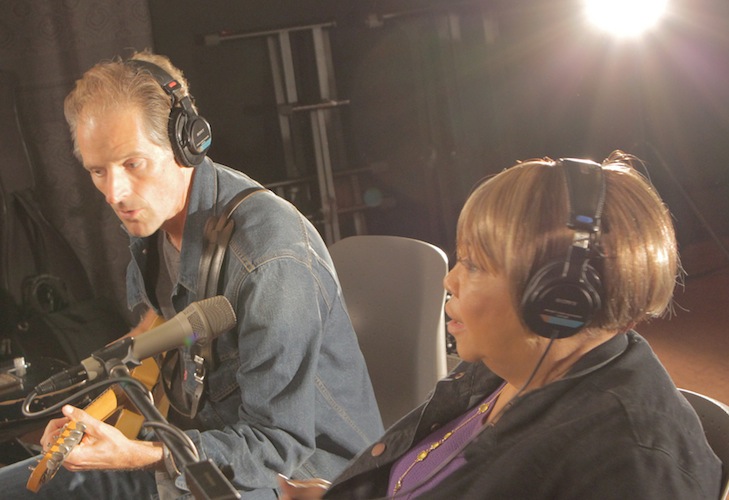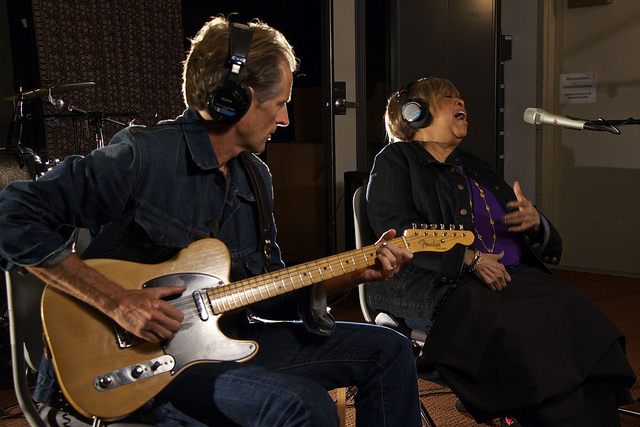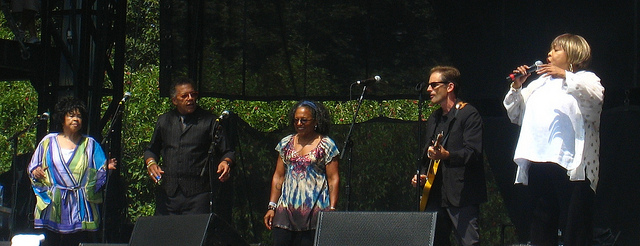Music Interview: Mavis’ Man — Guitarist Rick Holmstrom on Backing Mavis Staples With Taste and Space
“Yeah, Mavis Staples is everything you see onstage and more. She gives and gives and gives.”
By Noah Schaffer
After witnessing gospel and soul legend Mavis Staples’ then-new band play the Berklee Performance Center in 2008, a friend turned to me and said that “there ought to be a law that these guys have to back every classic soul singer.”
Most backing bands paired with classic R&B vocalists either try to dutifully recreate the original recordings or attempt to update the sound with synthesizers and power chords. But guitarist Rick Holmstrom, bassist Jeff Turmes and drummer Stephen Hodges take a unique approach, staring with the tasteful gospel approach of the late Staples Singers patriarch Pops Staples and then sending it into sonic dimensions not usually associated with classic soul.
The trio’s fruitful collaboration with Mavis was documented on the 2008 Live at the Hideout LP, and on countless YouTube videos filmed during Staples’ never-ending tours. Recently, Staples returned the favor by guesting on Holmstrom’s Cruel Sunrise LP. And the musicians will be on hand this Saturday (February 1) when Mavis plays Lexington’s Cary Hall as part of the unit that also features background singers Vicki Randle, Danny Gerrard, and Yvonne Staples. The Arts Fuse asked Holmstrom a few questions via e-mail.
Arts Fuse How’d you get the Mavis gig?
Rick Holmstrom: Well, first a little backstory: in the late ’90 and early ‘0s I recorded for a great label out of Boston called Tone Cool Records. They put out two of my solo records and three records that I co-produced with another artist. A few years later a couple of guys from Tone Cool, Dave Bartlett and Matt Cornell, moved into artist management and their first client was Mavis Staples. Dave told me he thought Mavis and I would make a good team, which sounded great to me. Honestly, I thought it was a long shot.
Eventually Dave asked me to play with Mavis as a duo at the Blues Awards show in Memphis. That went well, so then my band opened for Mavis on the Santa Monica Pier in 2006. It was a free concert with thousands of people and the added highlight of getting to see Mavis later! Well, as our set was winding down the promoter signaled for me to keep playing, which we did, for another 20 minutes or so. Turned out Mavis’ band was late getting in from the airport and we ended up backing her for the first 3-4 songs of her set. We hardly knew her songs but we did alright. I noticed some guy stage right who kept saying ‘Hey Rick…yeah man…right on!’ I just figured it was a friend of the promoter. As we were walking off the stage that guy tapped me on the shoulder. It was Ry Cooder. He really liked how we played and apparently kept mentioning it in the studio while producing a new record with Mavis (“We’ll Never Turn Back”). Later I played with Mavis at the NAACP Awards show, just one song for TV, and afterwards she asked me if I was ‘ready to make some noise?’ Of course I said yes and she told me, ‘Well, get your group together, let’s do it, Muntana!’ She calls everyone Muntana until she makes up some other nickname for you. So anyhow, we started with her in the spring of 2007. A few simple twists of fate, I suppose.
AF: Before you took over the band she had been touring with a band that included a keyboardist. Why’d you go with the guitar/bass/drums combo? Was it hard for Mavis to get used to this new, more wide open and atmospheric approach to her sound? How do you approach arranging songs that were recorded with larger bands?
Holmstrom: Yes, she had keys for years, but when I saw her in 2004/2005 she just had bass, drums and guitar along with her sister Yvonne singing backup. I really think Mavis sounds best in a stripped down setting because it gives her voice more room to resonate. Plus, a lot of my favorite Staples Singers stuff was just Pops Staples on guitar and their voices, occasionally with bass and drums too. To me, that’s where the deep Staples vocal blend really shines. It’s as if the singers are an orchestra horn section, punching and popping lines, being a lead instrument at times, not just singing “oohs and aah’s.” If you add too much it takes away from what makes it so soulful in the first place.
I think our sound falls somewhat into the mold of the Staples’ early Vee-Jay period and extends up into their STAX era too. Then we add some lowdown blues feel to it. Things just fell into place naturally with Mavis.
Jeff Turmes and Stephen Hodges and I like to say ‘Embrace the space.’ We like to use silence and a bigger range of dynamics than most bands. We try to play really quiet at times so that when we play at medium volume it has an impact, rather than starting on 10 and staying there all night. It also makes it easier on the six singers to really sing rather than strain to hear ourselves. It’s something we have to constantly work on, remind ourselves of.
A few years ago we played the RegattaBar in Cambridge and had the next night off, so we caught Ahmad Jamal there. Jeff, Hodge and I sat at the table maybe 10-15 feet from the band and we were floored by their dynamics. Spellbinding, really. We thought we were pretty dynamic, but they’re the masters. It was so inspiring. I think we’re still drawing from that one night in Cambridge.
Which reminds me, if you live in Boston and haven’t gone to see Duke Levine play, shame on you!
Elvis Costello sat in with us a few years back and said, “I’da swore there was more than three wee blokes up there!” I can’t really explain it. I suppose Jeff, Hodge and I play big. I don’t know. We’ve just been playing together for so long that we have this weird place where we put the notes, behind the beat a little. It’s where we put the pulse and leave the holes. Maybe it was the decades of van tours with older blues singers?
It also comes from the singers…Donny Gerrard, Vicki Randle and of course Yvonne Staples…if you’re jiving (or “half-stepping” as Mavis calls it) up there there’s a lot of experienced singers giving you the stink eye. All of these singers’ experience comes into play, sort of subtly and not so subtly shaping how we play and interact. And luckily, even though there’s a ton of talent onstage, there’s no ego trippin,’ we just try to put on a great show and have some laughs.
AF: Mavis’ recording career has remained very active. What’s the process behind adding a new song to the set list?
Holmstrom: Mostly it’s a combination of new material from her records, things people request, or things Dave and I dig up. Sometimes Donny will come up with things for Mavis. Usually the band will work a new song out in my hotel room, then ask Mavis and Yvonne over to try it. But I tell ya, it’s tough with an artist who’s been recording for 63 years… there are just so many songs… luckily Mavis turns anything she sings into her own song, so we’ll try something new and if she feels the lyric, if the groove is happening and if it works message wise within the set, it stays. If it falls short in any of those areas, it’s gone. I try make the set list different every night, then go over it with Mavis after sound check, but if I stray too far she’ll remind me that people want to hear a certain number of familiar songs. It usually won’t get too esoteric. I can count on one hand the number of times we’ve walked offstage without playing “I’ll Take You There.”
AF: Life on the road is notoriously tough. Is it true that Mavis is as gregarious and enthusiastic when traveling as she is on stage?
Holmstrom: Yeah, she’s everything you see onstage and more. She gives and gives and gives. A lot of times we’re all acting as watchdogs offstage just trying to shoo folks out of the dressing room quickly so she doesn’t wear herself out. Otherwise she’ll have no voice left come downbeat. Or worse yet, catch a cold and really wreck a tour. But yeah, it’s a lot of laughs, wishing I had the tape recorder going to catch the stories and the clowning around, which helps on those long travel days. She keeps everything light. She sorta is a light.
AF: You’ve also kept your own projects going. What kind of discipline is required to maintain those outlets when working with such a hard-touring act as Mavis?
Holmstrom: It’s fun, I love it…growing up in Alaska I worked construction, washed windows, cleaned bathrooms and pumped gas at a truck stop, then smelled people’s dirty socks selling running shoes in between tours in the ’90s…so this is a piece of cake. I get paid to make music!
Last week we recorded a record with Ben Hernandez, which I produced and can’t wait for folks to hear. There have been a lot of records that very few people hear. But I approach them all the same, just try to keep things fresh and keep growing. Really, everyone’s recording and doing gigs all the time. It’s a good thing. Hodge, Jeff and I try new stuff out on our [Los Angeles] Sunday night gig and lots of those experiments end up in the Mavis show.
Basically, other than my family, I live to play. A lot of nights I go back to my hotel room and work on my stuff after the Mavis show. That’s one good thing about Mavis not playing many club dates…we’re done early!
Over the past 15 years Noah Schaffer has written about otherwise unheralded musicians from the worlds of gospel, jazz, blues, Latin, African, reggae, Middle Eastern music, klezmer, polka and far beyond. He has won over ten awards from the New England Newspaper and Press Association.




Who is playing the brass instruments on Mavis’ “Since I fell for you?” I enjoy all the instruments although I cannot identify them all. Please email me what they are. I think I can hear an organ, guitar, violin, bass, piano and maybe the snare drum, and the part of the drum that sounds like a clock ticking. Is any or all of the aforementioned correct? I am particularly interested in the instrument that is played after Mavis says ‘Come on and blow your horn.’ Am I correct in concluding that this horn is either the alto or tenor saxophone.?
Please let me know.